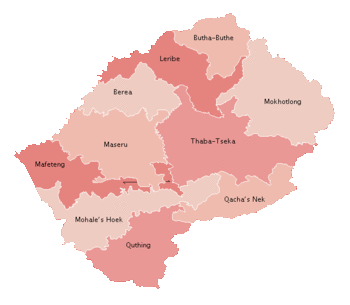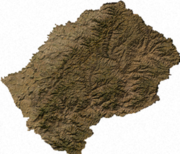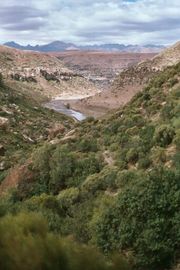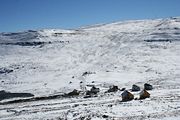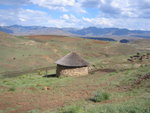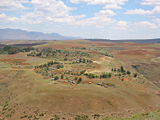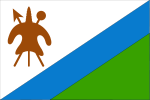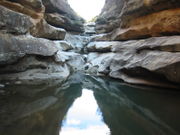Lesotho
2008/9 Schools Wikipedia Selection. Related subjects: Africa; African Countries
| Muso oa Lesotho Kingdom of Lesotho
|
||||||
|---|---|---|---|---|---|---|
|
||||||
| Motto: "Khotso, Pula, Nala" ( Sesotho) "Peace, Rain, Prosperity" |
||||||
| Anthem: Lesotho Fatse La Bontata Rona |
||||||
|
|
||||||
| Capital (and largest city) |
Maseru |
|||||
| Official languages | Southern Sotho, English | |||||
| Demonym | Mosotho (singular), Basotho (plural) | |||||
| Government | Constitutional monarchy | |||||
| - | King | Letsie III | ||||
| - | Prime Minister | Pakalitha Mosisili | ||||
| Independence | ||||||
| - | from the United Kingdom | October 4, 1966 | ||||
| Area | ||||||
| - | Total | 30,355 km² ( 140th) 11,717 sq mi |
||||
| - | Water (%) | negligible | ||||
| Population | ||||||
| - | July 2005 estimate | 1,795,0001 ( 146th) | ||||
| - | 2004 census | 2,031,348 | ||||
| - | Density | 59/km² ( 138th) 153/sq mi |
||||
| GDP ( PPP) | 2005 estimate | |||||
| - | Total | $4.996 billion ( 150th) | ||||
| - | Per capita | $2,113 ( 139th) | ||||
| Gini (1995) | 63.2 (high) | |||||
| HDI (2007) | ▲ 0.549 (medium) ( 138th) | |||||
| Currency | Loti ( LSL) |
|||||
| Time zone | ( UTC+2) | |||||
| Internet TLD | .ls | |||||
| Calling code | +266 | |||||
| 1 Estimates for this country explicitly take into account the effects of excess mortality due to AIDS; this can result in lower life expectancy, higher infant mortality and death rates, lower population and growth rates, and changes in the distribution of population by age and sex than would otherwise be expected. | ||||||
Lesotho (pronounced /lɪˈsuːtuː/ listen ), officially the Kingdom of Lesotho, is a land-locked country and enclave — entirely surrounded by the Republic of South Africa. Formerly Basutoland, it is a member of the Commonwealth of Nations. The name Lesotho roughly translates into "the land of the people who speak Sesotho.".
History
The earliest inhabitants of the area were Khoisan hunter-gatherers. They were largely replaced by Bantu-speaking tribes during Bantu migrations.
The present Lesotho (then called Basutoland) emerged as a single polity under paramount chief Moshoeshoe I in 1822. It was recognized by the United Kingdom on 13 December 1843, and on 12 March 1868 became one of the High Commission Territories. On 30 April 1965 it was granted autonomy. Its name changed when Lesotho gained full independence within the Commonwealth of Nations on October 4, 1966.
In January 1970 the ruling Basotho National Party (BNP) lost the first post-independence general elections, with 23 seats to the Basutoland Congress Party's 36. Prime Minister Leabua Jonathan refused to cede power to the Basotho Congress Party (BCP), declared himself Tona Kholo (Sesotho translation of prime minister), and imprisoned the BCP leadership.
The BCP began a rebellion and then received training in Libya for its Lesotho Liberation Army (LLA) under the pretence of being Azanian People's Liberation Army (APLA) soldiers of the Pan Africanist Congress (PAC). Deprived of arms and supplies by the Sibeko faction of the PAC in 1978, the 178-strong LLA was rescued from their Tanzanian base by the financial assistance of a Maoist PAC officer but launched the guerrilla war with a handful of old weapons. The main force was defeated in northern Lesotho and later guerrillas launched sporadic but usually ineffectual attacks. The campaign was severely compromised when BCP's leader, Ntsu Mokhehle, went to Pretoria. In the early 1980s, several Basotho who sympathized with the exiled BCP were threatened with death and attacked by the government of Leabua Jonathan. In September 1981 the family of Benjamin Masilo was attacked. A few days later, Edgar Mahlomola Motuba was taken from his home and murdered.
The BNP ruled by decree until January 1986 when a military coup forced it out of office. The Military Council that came to power granted executive powers to King Moshoeshoe II, who was until then a ceremonial monarch. But in 1987 the King was forced into exile after a falling out with the army. His son was installed as King Letsie III.
The chairman of the military junta, Major General Justin Metsing Lekhanya, was ousted in 1991 and replaced by Major General Elias Phisoana Ramaema, who handed over power to a democratically elected government of the BCP in 1993. Moshoeshoe II returned from exile in 1992 as an ordinary citizen. After the return to democratic government, King Letsie III tried unsuccessfully to persuade the BCP government to reinstate his father (Moshoeshoe II) as head of state.
In August 1994, Letsie III staged a military-backed coup that deposed the BCP government. The new government did not receive full international recognition. Member states of the Southern African Development Community (SADC) engaged in negotiations to reinstate the BCP government. One of the conditions Letsie III put forward for this was that his father should be re-installed as head of state. After protracted negotiations, the BCP government was reinstated and Letsie III abdicated in favour of his father in 1995, but Moshoeshoe II died in a car 'accident' in 1996 and was again succeeded by his son.
In 1997, the ruling BCP split over leadership disputes. Prime Minister Ntsu Mokhehle formed a new party, the Lesotho Congress for Democracy (LCD), and was followed by a majority of Members of Parliament, which enabled him to form a new government. Pakalitha Mosisili succeeded Mokhehle as party leader and the LCD won the general elections in 1998. Although the elections were pronounced free and fair by local and international observers and a subsequent special commission appointed by SADC, the opposition political parties rejected the results.
Opposition protests in the country intensified, culminating in a peaceful demonstration outside the royal palace in August 1998. Exact details of what followed are greatly disputed and it remain contested even within South Africa, but in September that year, a SADC task force operating on orders of unclear provenance entered the capital Maseru. While the Botswana Defence Force troops were welcomed, tensions with South African National Defence Force troops were high, resulting in fighting. Incidences of sporadic rioting intensified when South African troops hoisted a South African flag over the Royal Palace. By the time the SADC forces withdrew in May 1999, much of Maseru lay in ruins, and the southern provincial capital towns of Mafeteng and Mohale's Hoek had seen the loss of over a third of their commercial real estate. A number of South Africans and Basotho also died in the fighting.
An Interim Political Authority (IPA), charged with reviewing the electoral structure in the country, was created in December 1998. The IPA devised a proportional electoral system to ensure that the opposition would be represented in the National Assembly. The new system retained the existing 80 elected Assembly seats, but added 40 seats to be filled on a proportional basis. Elections were held under this new system in May 2002, and the LCD won again, gaining 54% of the vote. But for the first time, opposition political parties won significant numbers of seats, and despite some irregularities and threats of violence from Major General Lekhanya, Lesotho experienced its first peaceful election. Nine opposition parties now hold all 40 of the proportional seats, with the BNP having the largest share (21). The LCD has 79 of the 80 constituency-based seats. Although its elected members participate in the National Assembly, the BNP has launched several legal challenges to the elections, including a recount; none has been successful.
Politics
The Lesotho Government is a constitutional monarchy. The Prime Minister, Pakalitha Bethuel Mosisili, is head of government and has executive authority. The king serves a largely ceremonial function; he no longer possesses any executive authority and is proscribed from actively participating in political initiatives.
The Lesotho Congress for Democracy (LCD) controls a majority in the National Assembly (the lower house of parliament) with 62 seats. The All Basotho Convention (ABC), a party formed shortly before the poll under the leadership of former foreign minister Tom Thabane, is the main opposition. The Basotho National Party (BNP), the Alliance of Congress Parties (ACP) and the newly formed Basotho Batho Democratic Party (BBDP) and the Basotho Democratic National Party (BDNP) Lesotho are among the other five opposition parties represented.
The ABC has brought a dramatic change in the Lesotho's politics, due to it having won 17, mainly urban, seats out of 80 Constituency seats, only a few months after it was formed in September 2006. Of the 40 Proportional Representation (PR) seats, the National Independent Party (NIP), a parliamentary ally of the ruling party, has the highest number of seats at 21. The Lesotho Workers Party has the next highest number of proportional seats with 10. The BNP is the opposition party with the biggest loss in the February 2007 election with its representation reduced from 21 to 3 seats. A total of 12 political parties are represented in the 120-member parliament.
The upper house of parliament, called the Senate, is composed of twenty-two principal chiefs whose membership is hereditary, and eleven appointees of the king, acting on the advice of the prime minister.
The constitution provides for an independent judicial system, made up of the High Court, the Court of Appeal, Magistrate's Courts, and traditional courts that exist predominantly in rural areas. All but one of the Justices on the Court of Appeal are South African jurists. There is no trial by jury; rather, judges make rulings alone, or, in the case of criminal trials, with two other judges as observers.
The constitution also protects basic civil liberties, including freedom of speech, freedom of association, freedom of the press, freedom of peaceful assembly and freedom of religion.
Districts
Administratively, Lesotho is divided into ten districts, each headed by a district administrator. Each district has a capital known as a camptown.
|
|
|
The districts are further subdivided into 80 constituencies, which consists of 129 local community councils.
Geography
Lesotho covers 30,355 square kilometres (11,720 sq mi). The most notable geographic fact about Lesotho, apart from its status as an enclave, is that it is the only independent state in the world that lies entirely above 1,000 metres (3,300 ft) in elevation. Its lowest point is 1,400 metres (4,593 ft), and over 80% of the country lies above 1,800 metres (5,900 ft).
Climate
Due to its altitude, Lesotho remains cooler throughout the year than other regions at the same latitude. Most of the rain falls as summer thunderstorms. Maseru and surrounding lowlands often reach 30 ° C (86 ° F) in summer. Winters can be cold with the lowlands getting down to −7 °C (19 °F) and the highlands to −18 °C (0 °F) at times. Snow is common in the deserts and low valleys between May and September; the higher peaks can experience snowfalls year-round.
Economy
Lesotho's economy is based on exports of water sold to South Africa, manufacturing, agriculture, livestock, and to some extent the earnings of laborers employed in South Africa. Lesotho also exports diamonds, wool, mohair, clothing, and footwear. One of Levi's jeans manufacturing facilities is located there. Also in Lesotho is one of Russell Athletics plants. Lesotho is geographically surrounded by South Africa and economically integrated with it as well. The majority of households subsist on farming or migrant labor, primarily miners who remain in South Africa for 3 to 9 months. The western lowlands form the main agricultural zone. Almost 50% of the population earns some income through crop cultivation or animal husbandry, with over half the country's income coming from the agricultural sector.
Water is Lesotho's only significant natural resource. It is utilised through the 21-year, multi-billion-dollar Lesotho Highlands Water Project (LHWP), which began in 1986. The LHWP is designed to capture, store, and transfer water from the Orange River system to South Africa's Free State and greater Johannesburg area, which features a large concentration of South African industry, population, and agriculture. Completion of the first phase of the project has made Lesotho almost completely self-sufficient in the production of electricity and generated approximately $24 million annually from the sale of electricity and water to South Africa. The World Bank, African Development Bank, European Investment Bank, and many other bilateral donors financed the project. Lesotho has taken advantage of the African Growth and Opportunity Act (AGOA) to become the largest exporter of garments to the US from sub-Saharan Africa. Exports totaled over $320 million in 2002. Employment reached over 50,000, marking the first time that manufacturing sector workers outnumbered government employees.
Lesotho has nearly 6,000 kilometers of unpaved and modern all-weather roads. There is a short freight rail line linking Lesotho with South Africa that is owned and operated by South Africa.
The official currency is the loti (plural: maloti), but can be used interchangeably with the South African rand. Lesotho, Swaziland, Namibia, and South Africa also form a common currency and exchange control area known as the Common Monetary Area (CMA). The loti is at par with the rand, while one hundred lisente equal one loti.
Lesotho is a member of the Southern African Customs Union (SACU), in which tariffs have been eliminated on the trade of goods between other member countries Botswana, Namibia, South Africa, and Swaziland.
Lesotho has received economic aid from a variety of sources, including the United States, the World Bank, Ireland, the United Kingdom, the European Union, and Germany.
Tourism is a slowly growing industry. A ski resort recently opened in the high Maluti Mountains is drawing tourists from South Africa.
Significant levels of child labour exist in Lesotho, and the country is in the process of formulating an Action Programme on the Elimination of Child Labour (APEC), which is likely to be adopted in the period 2006-2007 (see Child labour in Lesotho).
Demographics
Population
Lesotho has a population of approximately 1.881 million, according to 2006 Census. The population distribution of Lesotho is 23.8 percent urban and 76.2 percent rural. Population density is lower in the highlands than in the western lowlands. Although the majority of the population -- 57.6 percent -- is between 15 and 64 years of age, Lesotho has a substantial youth population numbering around 37 percent. The annual population growth is -0.46%.
Languages
Lesotho's ethno-linguistic structure consists almost entirely of the Basotho, a Bantu-speaking people. The Kwena (Bakoena) are the largest subgroup of the Sotho; other Basotho subgroups include the Natal (North) Nguni, Batloung (the Tlou), Baphuthi (the Phuti), Bafokeng, Bataung (the Tau), Bats'oeneng (the tso'ene) and the Cape (South) Nguni (Thembu). Sesotho (Southern Sotho) and English languages are both official. Afrikaans, Zulu, Xhosa and French are also spoken.
Religion
Roman Catholics, the largest religious group, make up more than two-fifths of the population; smaller groups include the Lesotho Evangelical Church which comprises more than one-fourth of the population; Anglican, one-ninth; and other Christian and tribal religions.
Education and literacy
An estimated 85 percent of the population 15 and over was literate, according to recent estimates. As such, Lesotho boasts one of the higher literacy rates in Africa. Although education is not compulsory, the Government of Lesotho is incrementally implementing a programme for free primary education. It was expected that the program would be fully in place by 2006.
HIV/AIDS
Lesotho is severely afflicted by HIV/AIDS. According to recent estimates, the prevalence is about 29%, one of the highest in the world. The United Nations projects that this will rise to 36% within fifteen years, resulting in a sharp drop in life expectancy. According to the Lesotho Bureau of Statistics, in 2001 life expectancy was estimated at forty-eight years for men and fifty-six for women. Recent statistics estimate about thirty-seven years. Many children have lost parents. Traditionally lavish funerals leave survivors with another burden.
The government of Lesotho was initially slow to recognise the scale of the crisis, and its efforts to date in combating the spread of the disease have had limited success. In 1999, the government finalised its Strategic Plan on HIV/AIDS, a diagram for addressing the education, prevention, counseling, and treatment needs of the populace. In late 2003, the government announced that it was forming a new National AIDS Commission to coordinate society-wide anti-AIDS activities. Also in 2003 the government hosted a SADC Extraordinary Summit on HIV/AIDS.
In 2005, programs for the distribution of anti-retrovirals were initiated. One such program is in Hlotse, Leribe at Tsepong Clinic which is part of Motebang Hospital. However, such programs remain limited in resources and have relatively few participants.
The government has also started a proactive program called "Know your status" to test for HIV everyone in the country who wants to be tested. The program is funded by the Clinton Foundation and started in June of 2006. Bill Clinton and Microsoft chairman Bill Gates visited Lesotho in July 2006 to assess its fight against AIDS. Dubbed "The two Bills" by the media, the two men visited the Mafeteng Hospital which is about 80 kilometres (50 miles) south of the capital, Maseru, to assess progress in public health endeavours funded by their respective foundations.
Taxation
The taxation system in Lesotho has undergone major revisions in recent years (in part due to the establishment of the Lesotho Revenue Authority in 2003 - www.lra.org.ls).
Personal income tax: Personal income tax is due on income above M14,000 per annum, with a tax credit of M3,500. The standard rate is 25%, with a 35% rate on income over a certain threshold.
Company / corporate tax: The headline rate is 25%, with a special 10% rate on income generated from manufacturing, and a 0% rate for income generated from exporting manufactures to outside the Southern African Customs Union (the so called extra-SACU rate). Capital depreciation allowances exist and are 25% for most types of capital asset.
Value Added Tax: VAT was introduced in 2003 at 14% (replacing a 10% Government Sales Tax). An upfront VAT refund facility is in operation that effectively means that no VAT is paid on inputs into goods destined for export (a big help to Lesotho's garment exporters).
Dividends paid to non-residents and interest are subject to a 25 percent withholding tax. Resident companies that pay dividends must make an advance income tax payment of 53.8 percent, unless the dividends are paid out of manufacturing income or out of dividends paid by another resident company. Manufacturing companies pay no tax on dividends. Repatriated income is subject to a 25 percent tax.
Foreign relations
Lesotho's geographic location makes it extremely vulnerable to political and economic developments in South Africa. It is a member of many regional economic organizations including the Southern African Development Community (SADC), and the Southern African Customs Union (SACU). It is also active in the United Nations (UN), the African Union, the Non-Aligned Movement, the Commonwealth, and many other international organizations.
South Africa, the United States, Libya, Ireland, China, Botswana and the European Union all currently retain resident diplomatic missions in Lesotho. The British High Commission closed in 2005 and the UK is now represented in Lesotho by its High Commissioner resident in South Africa.
His Excellency, Prince Seeiso Bereng Seeiso is the present High Commissioner of the Kingdom of Lesotho to the Court of St. James's. The UN is represented by a resident mission as well, including UNDP, UNICEF, WHO, FAO, WFP, and UNAIDS.
Historically, Lesotho has maintained generally close ties with Ireland, but also with the United Kingdom (Wales in particular), Germany, the United States and other Western states. Although in 1990 it broke relations with the People's Republic of China (PRC) and re-established relations with Taiwan, it later restored ties with the PRC.
Lesotho also recognises the State of Palestine. In the past, it was a strong public supporter of the end of apartheid in South Africa and granted a number of South African refugees political asylum during the apartheid era.
Culture
Traditional musical instruments include lekolulo, a kind of flute used by herding boys, setolo-tolo, played by men using their mouth, and the women's stringed thomo.
The national anthem of Lesotho is "Lesotho Fatše La Bo-ntata Rona," which literally translates into "Lesotho, Land Of Our Fathers."
The traditional style of housing in Lesotho is called a rondavel.
The Morija Arts & Cultural Festival is a prominent Sesotho arts and music festival. It is held annually in the historical town of Morija, where the first missionaries arrived in 1833.
Human rights
Lesotho is a parliamentary constitutional monarchy. King Letsie III is the head of state but has no executive authority. In 2002, Prime Minister Pakalitha Mosisili was re-elected in what were judged to be free and fair elections. The government works to respect the civil and human rights of its citizens; however some serious abuses were reported in the past year. Police and security forces have been known to use excessive force and torture against detainees, often with impunity. The judiciary is subject to external influences and due process cannot be guaranteed. Lengthy pre-trial detention and long delays in trial are problems. Child labor and discrimination against persons with disabilities and HIV/AIDS are other known abuses committed in the region.
Assassinated leaders
- Selometsi Baholo, Deputy Prime Minister
- Makhele
- Motuba
- Seheri
- Selala Sekhonyana
- Sixishe



